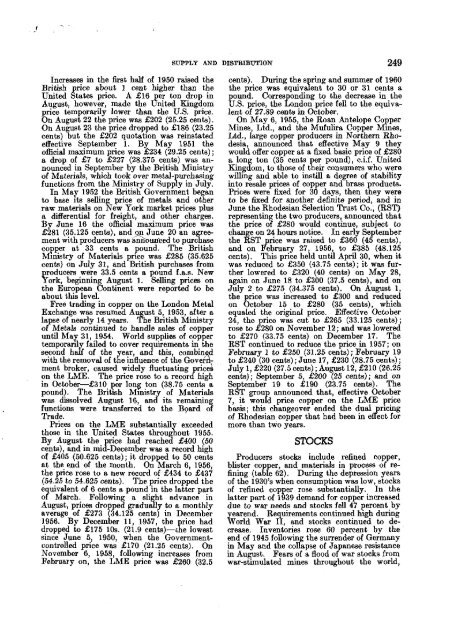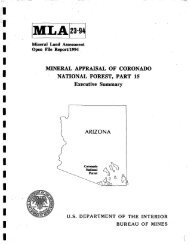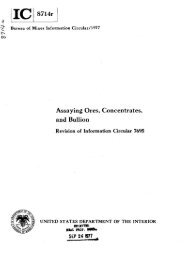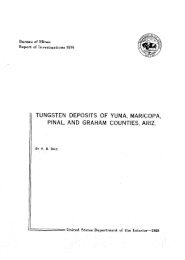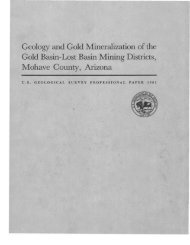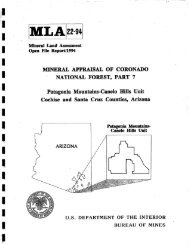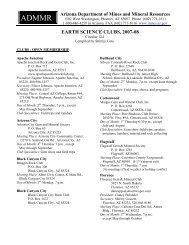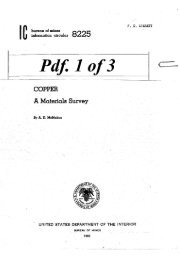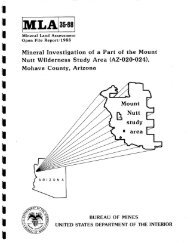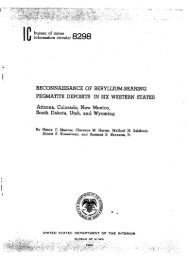IC 8225 - State of Arizona Department of Mines and Mineral ...
IC 8225 - State of Arizona Department of Mines and Mineral ...
IC 8225 - State of Arizona Department of Mines and Mineral ...
You also want an ePaper? Increase the reach of your titles
YUMPU automatically turns print PDFs into web optimized ePapers that Google loves.
Increases in the first half <strong>of</strong> 1950 raised theBritish rice about 1 cent higher than theUnited 8 tates price. A £16 er ton drop inAugust, however, made the 8nited Kingdomprice temporarily lower than the US. price.On August 22 the price was £202 (25.25 cents).On August 23 the price dropped to £186 (23.25cents) but the £202 quotation was reinstatedeffective September 1. By May 1951 theo5cial maximum price was £234 (29.25 cents) ;a drop <strong>of</strong> £7 to £227 (28.375 cents) was announcedin September by the British Ministry<strong>of</strong> Materials, which took over metal- urchasingfunctions from the Ministry <strong>of</strong> SupJy in July.In May 1952 the British Government beganto base its selling price <strong>of</strong> metals <strong>and</strong> otherraw materials on New York market prices plusa differential for freight, <strong>and</strong> other charges.By June 16 the <strong>of</strong>ficial maximum price was£281 (35.125 cents), <strong>and</strong> on June 20 an agreementwith producers was aaunced to purchasecopper at 33 cents a pound. The BritishMinistry <strong>of</strong> Materials pnce was £285 (35.625cents) on July 31, <strong>and</strong> British purchases fromroducers were 33.5 cents a pound f.a.s. New!fork, beginning August 1. Selling prices onthe European Continent were reported to beabout this level.Free trading in copper on the London MetalExchange was resumed Anpt 5,1953, after alapse <strong>of</strong> nearly 14 years. he British Min~stry<strong>of</strong> Metals continued to h<strong>and</strong>le sales <strong>of</strong> copperuntil May 31, 1954. World supplies <strong>of</strong> coppertemporanl failed to cover requirements in thesecond h d <strong>of</strong> the ear, <strong>and</strong> this, combin, dwith the removal <strong>of</strong> tze influence <strong>of</strong> the (lover$ment broker, caused widely fluctuating priceson the LME. The price rose to a record highin October--£310 per long ton (38.75 cents apound). The BritLsh Ministry <strong>of</strong> Materialswas dissolved August 16, <strong>and</strong> its remaininfunctions were transferred to the Bprd o ";Trade.Prices on the LME substantiall exceededthose in the United <strong>State</strong>s throug 1 out 1955.By August the rice had reached £400 (50cents), <strong>and</strong> in mix~ecember was a record high<strong>of</strong> £405 (50.625 cents); it dropped to 50 centsat the end <strong>of</strong> the month. On March 6, 1956,the price rose to a new record <strong>of</strong> £434 to £437(54.25 to 54.625 cents). The price dropped thee uivalent <strong>of</strong> 6 cents a pound in the latter part09 March. Following a sli ht advance inAugust, prices dropped gradu & y to a monthlyaverage <strong>of</strong> £273 (34.125 cents) in December1956. By December 11, 1957, the price haddropped to £175 10s. (21.9 cents)-~he lowestsince June 5, 1950, when the Governmentcontrolledprice was £170 (21.25 cents). OnNovember 6, 1958, following increases fromFebruary on, the LME price was £260 (32.5SUPPLY AND DISTRIBUTION 249cents). During the s ring <strong>and</strong> summer <strong>of</strong> 1960the price was equiv 3 ent to 30 or 31 cents apound. Corresponding to the decrease in theUS. price, the London price fell to the equivalent<strong>of</strong> 27.89 cents in October.On May 6, 1955, the Roan Antelope Copper<strong>Mines</strong>, Ltd., <strong>and</strong> the Mufulira Copper <strong>Mines</strong>,Ltd., large copper producers in Northern Rhodesia,announced that effective May 9 theywould <strong>of</strong>fer copper at a fixed basic price <strong>of</strong> £280a lon ton (35 cents per pound), c.i.f. UnitedKing f om, to those <strong>of</strong> their consumers who werewilling <strong>and</strong> able to instill a degree <strong>of</strong> stabilityinto resale prices <strong>of</strong> copper <strong>and</strong> brass products.Prices were fixed for 30 days, then they wereto be fixed for another definite period, <strong>and</strong> inJune the Rhodesian Selection Trust Co., (RST)representing the two producers, announced thatthe price <strong>of</strong> £280 would continue, subject tochan e on 24 hours notice. In early Septemberthe $ST price was raised to £360 (45 cents)<strong>and</strong> on February 27, 1956, to £385 (48.12;cents). This price held until April 30, when itwas reduced to £350 (43.75 cents); it was furtherlowered to £320 (40 cents) on May 28,again on June 18 to £300 (37.5 cents), <strong>and</strong> onJuly 2 to £275 (34.375 cents). On August 1,the price was increased to £300 <strong>and</strong> reducedon October 15 to £280 (35 cents), whichequaled the original price. Effective October24, the price was cut to £265 (33.125 cents);rose to £280 on November 12; <strong>and</strong> was loweredto £270 (33.75 cents) on December 17. TheRST continued to reduce the price in 1957; onFebruary 1 to £250 (31.25 cents); February 19to £240 (30 cents); June 17, £ 230 (28.75 cents);July 1, £220 (27.5 cents) ; August 12, £210 (26.25cents); September 5, £200 (25 cents); <strong>and</strong> onSe tember 19 to £190 (23.75 cents). TheR ~ grou T announced that, eilective October7, it wo& price copper on the LME pricebasis; this changeover ended the dual<strong>of</strong> Rhodesian copper that had been in e fPricing ect formore than two years.STOCKSProducers stocks include refined copper,blister copper, <strong>and</strong> materials in process <strong>of</strong> refining(table 62). During the depression years<strong>of</strong> the 1930's when consumption was low, stocks<strong>of</strong> refined copper rose substantially., In thelatter part <strong>of</strong> 1939 dem<strong>and</strong> for copper increaseddue to war needs <strong>and</strong> stocks fell 47 percent,byearend. Requirements continued high d mgborld War 11, <strong>and</strong> stocks continued to decrease.Inventories rose 60 percent by theend <strong>of</strong> 1945 following the surrender <strong>of</strong> Germanyin May <strong>and</strong> the collapse <strong>of</strong> Japanese resistancein August. Fears <strong>of</strong> a flood <strong>of</strong> war stocks fromwar-stimulated mines throughout the world,


